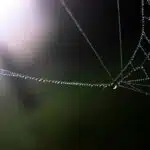Have you ever been mesmerized by the ocean and its majestic creatures? Now you can bring a bit of that wonder into your home with the string of dolphins plant. This unique succulent is sure to be an eye-catching addition to any room, and its care requirements are relatively simple. Like a dolphin gracefully swimming through the waves, caring for string of dolphins is like a dream come true.
The string of dolphins plant (Latouria dendroides) is part of the Aizoaceae family. Native to South Africa, this succulent is known for its long, trailing stems of small, rounded leaves resembling tiny dolphins in motion. Its unusual shape and texture make it a great choice for perking up dull spaces with some natural beauty. Whether your style is modern or traditional, the string of dolphins will add an extra splash of personality wherever it goes.
If you’re looking for an easy-care houseplant that thrives on minimal attention, then the string of dolphins could be just what you need! In this guide we’ll provide all the information needed to help this beloved succulent thrive in your home. So grab your snorkel gear and get ready to dive into our complete guide on growing and caring for string of dolphins!
Overview Of String Of Dolphins
What a coincidence! Just when you were looking for the best way to care and grow string of dolphins, here is a perfect guide. It has all the necessary information that will help you understand how to make your string of dolphins thrive.
String of dolphins, also known as Senecio peregrinus, belongs to the daisy family and is an evergreen perennial succulent native to South Africa. This trailing plant has beautiful foliage which looks like small dolphins swimming in the water – hence its name. It can grow up to two feet long with long stems featuring small round leaves with white or yellow margins. It grows best in temperatures between 65-75 degrees Fahrenheit and needs full sun exposure for most of the day.
The string of dolphins is easy to maintain and can be propagated easily with cuttings from its stems. To keep it healthy, it needs regular watering but too much water will cause root rot so make sure to keep soil moist but not soggy. Feeding it once a month during active growth with a balanced fertilizer will help promote new growth and blooms. Pruning is also important because this helps prevent plants from becoming leggy or overgrown. With these tips, you’ll have your own thriving string of dolphins in no time!
Light Requirements For Growing String Of Dolphins
A wise man once said, “If you want to achieve success, you must nourish your dreams with dedication and hard work.” This adage is especially true when it comes to growing string of dolphins in the home garden. Taking care of this plant requires more than just providing adequate light; however, let’s begin by exploring the essential requirements for lighting.
Light is a critical factor in the growth and development of string of dolphins plants. Ideally, these plants should receive direct sunlight for several hours during the day. However, too much direct sunlight can easily cause sunburns. For this reason, it is important to ensure that the plant gets dappled light instead of direct sunrays for most of its growth period. Additionally, if there are no sunny windows available in the home or office space, then artificial lighting such as fluorescent bulbs and LED lights may be used as a substitute.
The amount and duration of light exposure also depend on the season and climate. During winters or hot summers where the temperature rises above 85 degrees Fahrenheit (29 degrees Celsius), it is best to move the plants indoors or place them under partial shade outdoors. This will help protect them from extreme temperatures which can adversely impact their growth.
String of dolphins require more than just adequate lighting for healthy growth; they also need proper watering schedules to thrive in their environment. Therefore, let us explore how we can provide an optimal level of hydration for these beautiful plants next!
Water Requirements For Growing String Of Dolphins
Watering your string of dolphins is an essential part of its care. But, if you water it too much or too little, your plant won’t thrive. So, let’s take a look at the best way to keep your plant hydrated and healthy!
When watering your string of dolphins, you should aim for regularity and consistency. Water when the top inch of soil feels dry and be sure to water until it runs out from the pot’s drainage holes. During the growing season, you should water it about once every week or two weeks. In wintertime, reduce the frequency since this plant isn’t as active during colder months.
You can also mist the leaves occasionally to increase humidity around it – this will help keep its foliage looking lush and vibrant. Be sure not to overwater; soggy soil can cause root rot or fungal diseases which can kill off parts of your plant or even all of it. By keeping a consistent watering schedule and misting the leaves occasionally, you’ll be sure that your string of dolphins will stay happy and healthy!
Next up in caring for your string of dolphins is addressing its soil requirements – so let’s dive in!
Soil Requirements For Growing String Of Dolphins
As the sun sets on the day, so too do our expectations on what kind of soil is best for growing string of dolphins. Like a beautiful sunset, the healthy growth of these plants require the right soil conditions. Let’s explore what that looks like and how we can provide them with the perfect environment.
To start, it’s important to understand that string of dolphins prefer to grow in well-draining soils. This means that you’ll want to opt for a mix that holds moisture but still drains quickly; otherwise, you’ll risk overwatering and root rot. A good mixture may include a combination of potting soil mixed with perlite or sand. You may also want to add some organic matter such as compost or peat moss to aid in drainage and aeration.
When planting your string of dolphins, make sure to dig a hole large enough for the roots to spread out without becoming overcrowded. If possible, it’s best to use raised beds or containers so they don’t become waterlogged due to poor drainage from surrounding soil. Additionally, ensure that their location gets plenty of bright indirect sunlight during the day; this will help them thrive and keep their foliage lush and vibrant!
With these simple tips in mind, you’ll be able to set up your string of dolphins for success! The right soil requirements are critical for providing them with an ideal habitat that will allow these plants to live long and prosper. Now let’s take a look at what temperature requirements need to be met for optimal growth!
Temperature Requirements For Growing String Of Dolphins
The sun rises and so does the temperature, rising and falling with each passing day. As the temperatures gradually increase, you may find yourself wondering: What are the temperature requirements for growing string of dolphins? Like all plants, these charming succulents require certain conditions to thrive. Let’s explore what those needs are.
Think of string of dolphins as a tropical creature – they love it hot! These plants will do best in placement that is warm and sunny with temperatures ranging from 65-80°F (18-27°C). During the warmer months when your plant is actively growing, you may be able to get away with slightly higher temperatures; however, if your home or office space tends to reach hotter temperatures than this, it’s best to find another spot.
String of dolphins can also tolerate cooler conditions during their dormant period in wintertime; however, make sure not to let temperatures dip below 40°F (4°C) as you don’t want to risk freezing your plant. Keeping an eye on the thermometer during extreme weather times is a great idea.
Like Goldilocks trying out a few beds before she finds one that’s just right, you’ll want to make sure your plant has the perfect environment for growth. Too hot or too cold can both lead to problems such as wilting or other signs of stress – no one likes a stressed succulent! With just the right amount of warmth and sunshine though, you’re sure to have a healthy string of dolphins in no time.
Humidity Requirements For Growing String Of Dolphins
Have you ever wondered how to maintain the ideal growing environment for string of dolphins? Humidity levels are an important factor in keeping these plants healthy and thriving. So, what should you do to keep your string of dolphins flourishing?
It is recommended that string of dolphins be kept in a humid environment, usually between 40% and 80%. If you live in a particularly dry area, it is helpful to use a humidity tray or room humidifier. Placing your plant on top of pebbles filled with water can also help increase the humidity around your plants. It’s also beneficial to mist your dolphin strings every now and then. Doing this will also help remove any dust particles from its leaves.
In addition, it’s important to keep the air ventilated around your string of dolphins, as too much humidity can cause fungal diseases. Therefore, avoid putting them too close together or near sources of heat or cold drafts. Taking the time to adjust the humidity levels correctly for your plant will ensure that it continues to thrive for many years!
Propagating String Of Dolphins
Propagating string of dolphins is one of the most rewarding gardening projects you can take on. Much like a Caterpillar transforming into a Butterfly, you can watch as your String of Dolphins grows and multiplies from a single cutting. It’s an incredible process that requires patience, dedication, and some knowledge about the best methods for successful propagation.
To illustrate the potential for success in propagating String of Dolphins, I once took a single 5-inch cutting and watched it transform into two dozen full-grown plants over the next few months. With the right conditions, it was amazing to see how quickly they grew and multiplied!
The key to successful propagation is providing your cuttings with optimal humidity levels (around 60 to 70 percent). Set up a terrarium or humidifier near the plant to keep it moist but not too wet—you don’t want to drown your cuttings. Additionally, use sterile pruning shears when taking cuttings and make sure each one has at least 3 leaves attached. Once planted in soil with good drainage and bright indirect light, you should start seeing growth within 2 weeks.
With proper care and attention, propagating String of Dolphins can be a fulfilling experience that rewards you with lush foliage and beautiful blooms. Now that you know how to get started in propagating these plants, it’s time to move onto the next step: pruning them for optimal growth!
Pruning String Of Dolphins
Pruning your String of Dolphins is essential for maintaining their health and appearance. It’s an easy task that doesn’t require a lot of time or effort, but it can make a big difference in the look of your plant. To prune correctly, you’ll need to follow a few simple steps.
First, make sure you have a pair of sharp scissors or shears handy. Cut off any dead leaves or stems that are yellowing or wilting. This will help promote healthier new growth and keep your plant looking its best. When you’re done with that, look for thin, weak stems that don’t seem to be producing many leaves. Trim them back to encourage more growth and vitality in the overall plant.
Finally, if you want to shape up your String of Dolphins with more precision, you can lightly trim some of the longer stems as well. This will give the plant a neat, uniform look without affecting its overall health or growth rate. Just be careful not to overdo it! You don’t want to end up with an uneven-looking plant due to over-trimming.
TIP: To ensure healthy new growth on your String of Dolphins after pruning, give it plenty of bright light and water regularly throughout the growing season!
Common Pests And Diseases Affecting String Of Dolphins
Despite their beauty, string of dolphins aren’t immune to pests and diseases. According to research, more than 40% of all houseplants suffer from some kind of pest or disease. Fortunately, many pests and diseases affecting string of dolphins are minor and can be treated easily.
The most common issues for this plant include mites, aphids, scale insects, mealybugs and nematodes. These can all cause leaf discoloration and damage, as well as stunt the growth of the plant. If you detect any pests or diseases on your plant, it’s important to take action quickly by removing infected leaves or using a natural insecticide to treat the problem.
In order to prevent pests and diseases from occurring in the first place, make sure you’re providing your string of dolphins with proper care such as adequate sunlight, water and fertilizer. Also remember to inspect your plants regularly for any signs of damage or infection so that you can address the issue promptly. With these simple steps in mind, you’ll be able to keep your string of dolphins healthy and happy for many years to come!
Tips For Growing String Of Dolphins
If you’ve been looking for tips on how to grow string of dolphins, you’ve come to the right place. This delicate succulent is a beautiful addition to any garden, and with the right care, it can thrive for years. Here are 10 tips for growing string of dolphins:
Plant in well-drained soil: String of dolphins needs soil that drains well, so it’s important to avoid planting in soils with high clay content. A mixture of one part peat moss, one part perlite and one part potting soil will help ensure good drainage.
Water carefully: This plant does not like to be over-watered; make sure the soil has had time to dry out completely before you water again. It’s best to only water when the top two inches of soil are dry.
Provide bright light: Place your string of dolphins in a location with plenty of bright, indirect sunlight so it can get enough light without getting burned by direct sun exposure.
These three tips will help get your string of dolphins off to a great start! With regular repotting and proper watering, this beautiful succulent can become an eye-catching feature in your garden for many years to come. To keep your plant healthy and thriving, it’s important to address any pests or diseases that may arise as soon as possible. Knowing how to identify common issues will help you troubleshoot effectively and maintain a healthy plant population in your garden.
Common Uses For String Of Dolphins
String of dolphins is a unique houseplant that makes a beautiful addition to any home. With its trailing stems and ivy-like foliage, it provides an eye-catching effect that’s sure to be admired. But what can you do with these plants beyond simply admiring them? There are actually many uses for string of dolphins that make them incredibly versatile.
One of the most popular uses for string of dolphins is as an ornamental plant. With its bright green color and delicate foliage, it adds a touch of elegance to any room or garden setting. It can also be used as a hanging plant, which is perfect for those who have limited space in their home or garden. Not only does it look great, but it’s also easy to care for and maintain.
Another great use for string of dolphins is as a ground cover or filler between plants in your garden. This low-maintenance plant can tolerate most soil types and requires minimal attention once planted. Its ability to spread quickly makes it ideal for covering large areas or providing a backdrop for other plants in your landscape design. It’s also drought tolerant so you don’t have to worry about watering too often – just ensure that the soil stays moist during dry periods.
String of dolphins has so much to offer in terms of beauty, versatility and ease of maintenance! Whether you want to use it as an ornamental plant, fillers between other plants or even as a hanging plant, this attractive houseplant is sure to enhance any space you choose!
Toxicity Of String Of Dolphins
Caring for string of dolphins requires consideration of their toxicity. Unknowingly introducing this plant into a home or garden can have dangerous repercussions, so it’s essential to understand the potential hazards.
First and foremost, string of dolphins is poisonous to both humans and animals upon ingestion. All parts of the plant contain toxins that can cause nausea, vomiting, and other discomforts. To be safe, keep these plants away from children and pets who may not know better than to nibble on them.
It’s also important to note that string of dolphins can irritate skin upon contact with its sap or leaves. Eye contact may cause redness and burning sensations; therefore, it’s best to wear gloves when handling the plant and keep it out of reach from curious hands and paws.
Taking these precautions will help ensure a safe environment for everyone in your home or garden. By understanding the dangers associated with string of dolphins, you can make an informed decision about whether it’s the right choice for your space. Now that we’ve discussed toxicity, let’s dive into fertilizing this plant for optimal growth!
Fertilizing String Of Dolphins
You’ll be amazed at the way your string of dolphins will thrive with the right fertilizing techniques! Fertilizing your string of dolphins is an absolute must for a healthy, vibrant plant. It’s like the difference between night and day; you’ll be astounded by how much better your plants look after fertilizing them!
To get the best out of your string of dolphins, start with a balanced fertilizer that is high in potassium and phosphorus. You can also use slow-release or liquid fertilizer as they both work well. When applying any type of fertilizer, make sure to water it thoroughly afterwards to help it absorb into the soil. Additionally, avoid overfertilizing as this can lead to negative consequences such as leaf yellowing and burning.
It’s also important to consider timing when it comes to fertilizing your string of dolphins. Most plants benefit from being fertilized once every four weeks in spring and summer, and once every six weeks during fall and winter. This ensures that your plants are getting all the nutrients they need throughout the year while avoiding overfeeding or nutrient deficiencies.
With these tips in mind, you can ensure that your string of dolphins stay happy and healthy all year round! By following these steps, you’re setting yourself up for success in caring for these beautiful plants – so don’t wait any longer and get started today!
Troubleshooting Common Issues With String Of Dolphins
Troubleshooting issues with string of dolphins isn’t easy, but with a little know-how, you can make sure your beloved plant remains healthy and happy.
It’s a stark contrast to the carefree process of planting and growing them – troubleshooting issues requires a lot of effort and attention. But don’t worry, we’re here to help! In this section, we’ll explore common problems gardeners experience while caring for string of dolphins and how to resolve them.
First off, it’s essential to ensure your plants are getting enough light. If they’re not exposed to enough bright light during the day, their leaves may start to wilt or turn yellow. Providing adequate sunlight is key for keeping your plants healthy and vibrant. Additionally, don’t forget to water your plants regularly – they should be kept moist but not overly wet. Otherwise, you risk root-rot which can cause irreversible damage if left unattended.
By following these steps and taking the time to troubleshoot any issues that arise with your string of dolphins, you can rest assured that your plants will remain in excellent condition for years to come.
Long-Term Care For String Of Dolphins
String of dolphins: a symbol of longevity and perseverance in care and growing. With its mesmerizing grace, it is no wonder why this plant has become a favorite among gardeners. But to ensure that the string of dolphins remains healthy, long-term care is essential.
This 15th step in our guide for caring for string of dolphins will provide you with all necessary information on how to keep your plants thriving for years to come. Properly caring for your string of dolphins requires dedication and commitment, but the rewards are worth it!
Developing a regular watering and fertilizing schedule, as well as providing enough sunlight and air circulation are key to ensuring that your string of dolphins have what they need to stay healthy. Regularly pruning off dead or damaged leaves directly benefits the health and growth of the plant, as does avoiding overwatering which can lead to root rot. With these tips and tricks at hand, you’ll be sure to enjoy a vibrant string of dolphins that will remain healthy for many years in the future!
Frequently Asked Questions
How Often Should I Water My String Of Dolphins?
String of dolphins, also known as Senecio peregrinus, is a unique and eye-catching houseplant with long cascading vines. It has an interesting shape that looks almost like a string of dolphins swimming in the water. Caring for this plant isn’t difficult, but it’s important to understand how much water it needs.
When winter comes around, you don’t need to water your string of dolphins as much. This is due to the amount of natural light and temperature drops during this time. During the summer months however, when temperatures are hotter and there’s more sunlight, your string of dolphins will need more hydration. Ideally, you should be watering your plant every 7-10 days or when the soil feels dry to the touch at least 1 inch down. This ensures that your plant won’t become overwatered or suffer from root rot.
It’s important to remember that while string of dolphins do need regular waterings, they also have certain preferences and tolerances when it comes to humidity levels and drainage capabilities. While they prefer soil with good drainage capabilities and low humidity levels, they’re not picky about soil composition as long as it’s well ventilated and moist enough for them to thrive in their environment. So if you want your string of dolphins to remain healthy, make sure that you provide them with adequate moisture levels without overdoing it on the waterings!
How Quickly Does String Of Dolphins Grow?
The speed at which a plant grows is often seen as a measure of its health and vitality, so many gardeners are interested in finding out how quickly their String of Dolphins will grow. But what’s the truth behind this theory? A closer look reveals that String of Dolphins will grow relatively quickly under optimal conditions:
• With adequate water and fertilizer, String of Dolphins will add about 4-6 inches to its length per month. • If you prune it regularly, the growth rate may be even faster. • Warm temperatures encourage more rapid growth, while cooler temperatures slow it down. • Making sure the plants get plenty of sunlight will also help them to grow more quickly.
With careful attention and maintenance, you can ensure your String of Dolphins grows at its best possible rate. By providing the correct levels of light, water, nutrients and temperature, you can keep your plant healthy and growing fast – but don’t forget to prune it regularly for an even better result! The best part about taking care of a String of Dolphins is watching it thrive – so why not start now?
Is String Of Dolphins Suitable For Indoor Potting?
The journey of growing a string of dolphins is like an adventure of discovery. It’s not only rewarding to watch something living and vibrant take shape, but it also brings a feeling of accomplishment. If you’re looking for an indoor potting option, string of dolphins may be the perfect choice.
This succulent is relatively easy to care for, making it suitable for both newbie and experienced plant parents alike. Its trailing vines can reach up to three feet in length, with small round leaves resembling dolphins along the way. Though it does require some sunlight, it’ll be perfectly fine with bright indirect light or artificial lighting – meaning it can thrive indoors.
When planting your dolphins, make sure to use a well-draining soil mix as they don’t like wet feet! Water thoroughly and allow the soil to dry out between waterings; this will help prevent root rot from setting in. With regular watering and occasional fertilizer application during the growing season you should have healthy plants that can last for years!
String of dolphins makes a great addition to any home or office space – so why not give them a try? They’re sure to bring life and vibrancy into your home, while giving you plenty of opportunities for learning about plant care and cultivation along the way.
How Often Should I Fertilize My String Of Dolphins?
When it comes to caring for your string of dolphins, fertilization is a must! It’s like the cherry on top of an already delicious sundae – an absolute essential. Hyperbole aside, there are few things more important than making sure you’re giving your plant the nutrients it needs. Here’s a quick guide on how often you should fertilize your string of dolphins:
Depending on the season and your climate, you’ll need to add fertilizer about twice a month during spring and summer.
In fall and winter months, however, reduce that frequency to once every two or three months.
If you’re noticing that your plant is looking sad with yellowing leaves or stunted growth, it might be time to increase the amount of fertilizer.
You can also give it a boost by adding liquid fertilizers every so often straight into its waterings.
Fertilizing isn’t just about helping your string of dolphins look its best – it’s about ensuring that it receives all the necessary nutrients to be healthy and strong. Giving your dolphins the right kind of care will ensure they keep growing happily for years to come! So don’t forget – stay on top of regular fertilizer applications and keep those dolphins smiling!
Can I Grow String Of Dolphins Outside?
The fragrant and swaying string of dolphins is a captivating sight to behold. Its delicate tendrils and mesmerizing foliage make it an attractive addition to any garden. But one question that often comes up for gardeners – can you grow string of dolphins outside?
The answer is yes, with a few considerations. As the plant prefers warmer temperatures, it won’t be suitable for cold climates; however, if you live in a temperate area with mild winters and warm summers, then you can certainly keep your string of dolphins outdoors. Just bear in mind that the plant may need some protection from strong winds or direct sunlight in the hottest months.
As with all plants, it’s important to give your string of dolphins the right care and attention. Make sure it gets enough water, but don’t overwater as this can cause root rot; provide adequate drainage; feed your plant with a balanced fertilizer every couple of months; and prune regularly so that its growth doesn’t get out of hand. With these simple tips in mind, you’re sure to have success growing this beautiful trailing houseplant outdoors!
Conclusion
String of dolphins is a beautiful plant that can be a great addition to any home. With the proper care and knowledge, you can keep your string of dolphins looking its best! Water your string of dolphins moderately and fertilize it at least once every two months to ensure its health. If you want to take your string of dolphins outside, make sure you choose an area with lots of indirect sunlight and protection from extreme temperatures.
In conclusion, caring for a string of dolphins is not difficult if you know what to look out for. It’s like having an underwater garden in your living space – all the beauty without the mess. With patience and dedication, your string of dolphins will thrive, creating a captivating display for years to come! So don’t be afraid to dive into this wonderful plant and experience the joys of having a little piece of the ocean in your home.





























